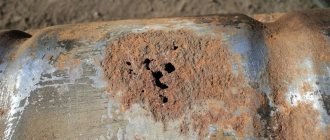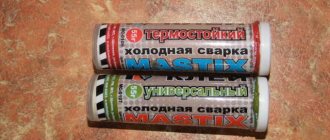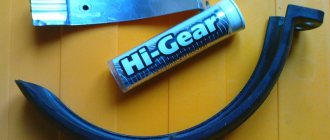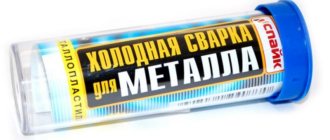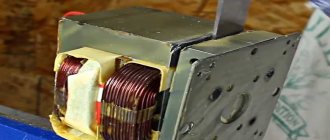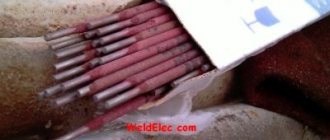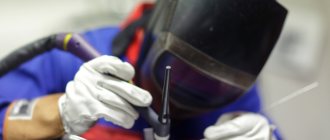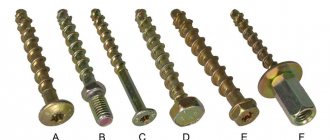How to cook stainless steel - welding methods
The choice of welding method is most often associated with the product itself. Simply put, if an aircraft engine part made of a heat-resistant chromium-nickel alloy falls off in a factory environment, then automatic and semi-automatic welding methods will be used.
If welding is carried out in everyday life, for example, a tank in a bathhouse, then the manual arc method will be used.
We list the main methods that are used in production when welding stainless steel:
- in an argon environment with a non-consumable electrode;
- semi-automatic in a gas mixture or in a pure inert gas environment;
- plasma;
- contact;
- laser and electron beam;
- Manual consumable electrode
- pressure welding (cold).
Now let's look at the methods that are used at home:
- manual arc - the most commonly used.
- Semi-automatic in argon or flux-cored wire - used infrequently, usually for repairing equipment.
How to cook stainless steel with an electrode (MMA)
In order to weld corrosion-resistant steel with electrodes, the first thing you need to do is select the right electrodes. The use of electrodes not intended for welding stainless steel very often leads to cracking of the seam and corrosion.
Another negative point is that the strength of the weld will be lower than that of the base metal of the part.
Read about how to choose the right one in the article - Stainless steel electrodes for welding stainless steel with an inverter.
Now we will not dwell on this method in detail, but will analyze it in detail below in the section: How to weld stainless steel with an electrode at home.
How to cook stainless steel with argon (TIG welding)
Unlike welding with stick electrodes, the process in an argon environment is performed with a non-consumable tungsten electrode. This type of arc welding is very suitable for thin metal, where the thickness is no more than three millimeters. It is not very advisable to use for thicker parts since the process is quite slow.
In this way, stainless steel is cooked using direct current of direct polarity - when the plus is connected to the part itself, and the minus to the burner.
It is best to use devices equipped with non-contact arc ignition (equipped with an oscillator). If, after all, the apparatus is simpler and does not contain this device, then it is best to ignite the arc on a graphite lining and move the arc onto the product. If this is not available, then we ignite the arc using the contact method, but in this case a burn from the contact will remain on the structure electrode.
At the very beginning of the process, it is necessary to carry out a gas purge to remove any remaining air from the torch and hoses, as well as to protect the welding site.
During the welding process, you must carefully ensure that the filler wire and non-consumable electrode are constantly in the protective gas zone. Otherwise, the seam will be saturated with oxygen and nitrogen due to poor protection, and the arc will burn unstably.
When welding stainless steel, it is extremely important to maintain a minimum arc length.
We keep the arc as short as possible, otherwise we will get hot cracks in the fusion zone and near-heat zone.
Read more about what tig welding is in our article at the link.
In order not to reduce the corrosion resistance of the metal, it is necessary to cool it as quickly as possible. A water-cooled copper pad is often used for this purpose. If they are not there, it doesn’t matter, you can simply apply one layer and wait until it cools down to 100-115 degrees.
Stainless steel tig welding works very well both in pure argon and in its mixture. You can read in detail about the mixture of gases in our article - Welding mixture for semi-automatic and tig welding.
Most often, a mixture of argon 80% + 20% CO 2 is used.
Before electric welding, edges are prepared using mechanical processing, plasma cutting, arc cutting or gas flux cutting followed by mechanical processing. A distance of 20 mm from the edge must be cleaned to a shine, removing scale and oxide film. After this, the edges must be degreased in cases where high quality seams are required.
The process is carried out without oscillatory movements of the burner - a so-called thread seam is performed. The filler wire is fed at an angle close to 90 degrees to the electrode. The additive must be applied evenly to reduce splashing. Let us repeat once again that it is very important to weld stainless steel with a short arc.
Semi-automatic (Mig/Mag welding) in argon or mixture
Semi-automatic electric welding of stainless steels in argon or gas mixtures is quite common. As a rule, semi-automatic machines are used for joining small thicknesses. This method is not very different from welding with stick electrodes in terms of the connection method. The process is also performed in reverse polarity. The arc burns between a melting electrode wire, which, unlike a piece electrode, is fed automatically through the torch nozzle.
This ensures uninterrupted work since the welder does not have to stop to change the electrode, and also protect the place where the arc breaks, which is mandatory when welding with electrodes.
This method compares favorably with tig welding due to its high productivity. This is especially true for welding long seams.
You can read more about how you can cook stainless steel with a semi-automatic machine in our article - How to cook stainless steel with a semi-automatic machine.
Cold (high pressure)
Now let's look at a technology such as cold welding under pressure (also called diffusion welding). This technology is used in large enterprises to connect very important parts that cannot be overheated. This method is also used to join materials with low weldability. The process is carried out in special installations in which the parts being connected are compressed (sometimes the parts are preheated). Compression can be either unilateral or bilateral.
The seam when using this type of welding is narrow and looks very aesthetically pleasing. There are no foreign inclusions in the form of slag or tungsten particles. In addition, there is virtually no heat-affected zone, which increases the strength of the connection. This almost completely eliminates the appearance of stress in the metal, and consequently, the deformation of the product.
Laser
To work with stainless steel, this method is used, like the previous one, in large enterprises. This is a very productive, high-precision and at the same time very expensive technology. When using a laser beam, the weld pool has extremely small dimensions and at the same time a high temperature of the molten metal. This has a very positive effect on welding corrosion-resistant and stainless steels. This is because overheating of the metal is minimal.
The seam will have a fine-grained structure without various inclusions. A special feature of this method is also its very high productivity, as well as high quality connections.
Plasma
Plasma welding of stainless steel is most widespread in the range of small thicknesses, the so-called microplasma welding in the range of up to 1-1.2 mm. Due to the high temperature created by the plasma flow (in the middle of the column the temperature is about 20,000 degrees), the high productivity of this method is ensured. The equipment used for this method is:
- manual - used in the thickness range up to 7-8 mm.
- Automatic - used for welding large thicknesses up to 38-40 mm in one pass.
contact welding
This technology is used in large enterprises, because resistance welding installations are large and very expensive. This method is good because the process is very easy to automate. This is very relevant where there is a large flow of products (serial and mass production).
For stainless steel, this method can be used both as a point method and as a suture method.
Spot welding occurs when the product is compressed by two contacts of the installation and current is passed through the contacts. The result is a connection in the form of a point.
This method is used when the thickness is small, no more than 0.3 to 5.9-6 mm. In cases where it is necessary to make an extended connection, the suture method is used.
The principle here is the same, only instead of two compressive electrodes, rollers are used. Current is applied to the roller, and the product is pulled through it and welded.
For stainless steel, this method is often used because the heating in it is local and the temperature is low, and this has a very good effect on quality. Due to the reduction of warping and welding deformations in the product.
Which cold welding to choose?
VIEW Cold welding on AliExpress →
Due to the huge range, it can be difficult to identify an obvious leader. Even studying the instructions for a person who has little knowledge of directions will not bring clarity to the situation. To make it easier for you to resolve the issue, we present to your attention the top 3 best cold metal welding tools that you can find on the market in 2022.
1) Weicon VA 110
| Price | ★★★ (3.0 out of 5.0) | Overall attractiveness ★★★★★ 4.0 |
| Seam strength | ★★★★★ (5.0 out of 5.0) | |
| Reviews | ★★★★★ (5.0 out of 5.0) |
Supplied in 60 gram tubes. The cost of one such tube reaches 3,500 rubles, which makes cold welding one of the most expensive options for the average consumer.
Among the advantages, we note the NSF certificate of environmental friendliness + safety of components for human health, high strength of 20 N per square millimeter and high polymerization rate. Disadvantages - 24 hours until complete hardening and the need to apply a thin layer (up to 0.02 centimeters), which requires extreme care from a person during the work process.
2) Weicon RK-1500
| Price | ★★★★ (4.0 out of 5.0) | Overall attractiveness ★★★★★ 4.5 |
| Seam strength | ★★★★★ (5.0 out of 5.0) | |
| Reviews | ★★★★★ (5.0 out of 5.0) |
The best option in terms of price/quality ratio. Works with both light and heavy metals. Can be used for gluing elements joint to joint.
The glue works well on smooth surfaces + it can be applied on both sides, with a total thickness of up to 1 millimeter. The disadvantages are accuracy during application due to the two-component composition, 100% strength only after a day and a high fluidity rate of the activator. Price on the market from 1,200 rubles.
A practical example of the use of cold welding with an explanation of the nuances of use for different materials:
3) Poxipol “Cold welding”
| Price | ★★★★★ (5.0 out of 5.0) | Overall attractiveness ★★★★★ 4.0 |
| Seam strength | ★★★★ (4.0 out of 5.0) | |
| Reviews | ★★★★ (4.0 out of 5.0) |
In terms of price, the most affordable option is from 600 rubles. The weld hardens quickly. The tear test can be carried out after 10 minutes, and for full use a couple of hours of hardening of the seam will be enough.
Among other advantages, we note resistance to aggressive environments and increased adhesion rates. Disadvantages of the product - polymerization 24 hours after use, it will not work for joint welding, and does not perform well in small cracks and overlapping parts.
Other options worth considering include Strong steel stick renewal composite, EpoximaxX and Bison Super Glue Gel. The latter refers to general-purpose cold welding, and therefore, when gluing glass, wood, plastic and other household materials, it will work with a bang.
In any of the presented options, there are detailed instructions on how to use cold welding with a description of the technological nuances of using the current adhesive substance.
How to weld stainless steel with an electrode at home
At home, you most often have to cook stainless steel with a cheap inverter and a conventional electrode for these steels. In this section we will focus on the features and techniques of electrode welding; this will be useful to you if you are a novice welder.
Now let's briefly look at the welding procedure.
We prepare the part that needs to be welded for welding, clean the edges to a metallic shine, it is advisable to degrease the surface.
The edges of the part themselves must be cut according to GOST if the thickness of the part is 3 millimeters or more. Edge cutting is most often done with a sander.
We connect the device. A very important point is polarity when welding. In our case, we use reverse polarity (we connect the plus of the device to the holder, and connect the ground cable to the minus).
If you don’t have a machine or need to find out what types of welding machines there are, then follow the link.
Now you need to tack so that the edges do not separate during the welding process. The tacks are placed at a distance of 100–160 mm from each other. The length of the tacks is usually from 10 to 50 mm. The tacks need to be melted or sawed off during the welding process. Practice shows that if the requirements for a seam are high (the seam will undergo non-destructive testing), then the tacks need to be cut out, otherwise pores will form.
Now you can start welding.
Let us make a reservation if you need to cook, but the air temperature is below minus 10 degrees, then the products need to be heated with a gas burner or inductor to 100 - 120 degrees.
To start welding, you need to light the arc. This is done as follows: a welding electrode fixed in a holder brings the parts and touches the surface with the end of the electrode several times.
There are 2 types of movements: pecking - tapping the tip of the electrode on the surface and striking - the same movement as when lighting a match. In this case, there are no special recommendations on what to use, here those who are used to it do so.
You need to cook stainless steel at a minimum current so as not to overheat the metal; for this you need to use electrodes with a small diameter of 1.6-2.5 mm (3 mm in extreme cases). If you use electrodes of larger diameter, the process will be greatly complicated due to overheating.
The process itself should be kept short; the length of the arc should not be more than one diameter of the electrode. This condition is more of a recommendation, but compliance with it provides better protection.
Stainless steel has a high coefficient of casting expansion, which means that the material greatly increases in size when heated during the welding process. Because of this, it becomes deformed (the part bends). To avoid this effect, you must not overheat the metal, you need to monitor the temperature of the main part near the welding zone and not allow the temperature to rise above 150-180 degrees Celsius.
If the seam is long and you have to change the electrodes, the place where the arc was broken must be cleaned with a grinder, and welding continues with a new electrode. If the breakage area is not cleaned out, someone in it will end up with pores.
If the welding is multi-pass, then after performing one pass it is necessary to wait until the metal cools to a temperature of about 100 degrees. This condition is also necessary to reduce intergranular corrosion, the risk of formation of which increases if the metal is severely overheated.
Also, for multi-pass welding, it is very important that the locks of the weld seams do not coincide. They must be offset relative to each other.
After welding is completed, the weld seam and the base metal next to it must be cleaned of slag and splashes. Cleaning can be done with a metal cord brush for a sander or a hand brush. at home, you can clean it with an abrasive disc, but in production they try to avoid this because the weld metal cannot be machined.
We have a useful article for beginners; you will learn what electrode welding is, basic methods and exercises to quickly learn. Follow the link.
Preparatory work
Let's take a closer look at what preparatory work is necessary when welding stainless steel with electrodes. The very first thing you need to check is the serviceability of the equipment. You cannot use faulty equipment, uninsulated cables, and it is undesirable to use homemade holders. Not only the quality of the work performed, but also your safety depends on this. There are many sad examples of this.
The second thing that is important is to check the serviceability of the chameleon welding helmets (if you have one, of course). The mask should darken quickly and sufficiently. You can check it without welding, just turn on the mask, point the glass with filters at the light (at a spotlight in the workshop, at a window, etc.) and wave your hand in front of the glass. If the mask has darkened, then everything is fine and it is in working order.
Third, drying (calcination) of the welding electrodes in the oven, according to the regime indicated on the pack of electrodes. It is highly undesirable to carry out work, especially on high-alloy steel, without drying. This is fraught with a large number of pores in the seam.
Fourth - preparing parts for welding: cleaning the edges of the workpiece to a shine at a distance of at least 20 mm. If there are high quality requirements for the part, the edges must be degreased with a solvent or a water-alcohol solution.
What electrodes should be used to cook stainless steel with ferrous metal?
It is best to weld stainless steel with ferrous metal using specialized electrodes of the OZL-6 brand. This brand is inexpensive, the connection is of high quality. Currently, there are a large number of brands of so-called transition electrodes - those that are used to connect ferrous metals with alloyed ones.
Read in detail in our article - Stainless steel electrodes for welding stainless steel with an inverter.
Welding thin stainless steel
Thin stainless steel burns very easily, so it is quite difficult to cook. If possible, of course, it is better to use semi-automatic welding or in argon with a non-consumable electrode.
Read more about what semi-automatic mig welding is in the article at the link.
These methods provide less heating of the metal and better protection. If the thickness is less than 1 mm, then you need to use microplasma, contact or laser technology.
If you still have to weld with piece electrodes, then it is best to weld thin stainless steel with an inverter with a breakaway or provide a heat sink in the form of a copper water or air-cooling lining on the reverse side.
Tear-off welding is performed as follows: the arc is ignited, a short section of no more than 20-25 mm in size is welded, and the arc breaks. Afterwards the process is resumed again, also boiling 20-25 mm. The bottom line is that at the moment of breakage, the metal cools down and the risk of burnout is reduced.
Fitting method
You can connect metal pipes without welding using fittings. The element is fixed on the pipeline with a specialized ring. The degree of clamping is adjusted with a nut.
Manufacturers produce fittings designed for the installation of metal pipes. The method allows you to obtain a reliable joint that prevents leakage. Fittings are installed when assembling pressure systems. The selection of an element is carried out taking into account the scope of its application.
According to their design, fittings are divided into several groups:
- Straight-through with a constant internal diameter. The pipeline capacity does not change.
- Knees. When installing such a fitting, the water supply turns at an angle of 90 or 45 degrees. Used to shift the highway in a vertical or horizontal plane.
- Deaf. They have one connection side. They are used as plugs for blocking pipes.
- Triples. They have three connection connectors. Used to branch a highway.
- Cross. Used when joining 4 pipes simultaneously.
- Transitional. The diameter of the connectors of one part is different. The capacity of the highway changes.
- Fittings. Serve for joining metal pipes with hoses.
The type of fitting is selected taking into account the location of its installation. Using clamping structures, you can connect metal pipes without welding.
Welding modes
As mentioned earlier, the technology of welding stainless steel with an electrode has a number of features, such as: the need for a high speed of the process and a minimum current value. In this regard, the process execution modes differ from the modes for carbon steels. The table below shows the modes for corrosion-resistant steels.
| Welding method | Layer (roller) number | Diameter of wire and electrodes mm | Type of current, polarity | Welding current, A |
| RD | 1 (root) | 2,5 | Constant, reverse polarity | 60-90 |
| 2, etc. | 3 | 80-110 |
Modes for welding in argon with a non-consumable electrode
Modes for resistance welding
Modes for plasma welding
Useful article - How to cook aluminum
Connection using a repair and mounting clip
The main area of application of the design is restoring the integrity of the highway after a break. Using a clip, seal the resulting hole.
The design provides for the presence of two metal parts with holes for fasteners. Compression of individual elements is carried out by bolts and nuts. There is an elastic seal between the parts of the holder.
The pipeline at the site of the rupture is cleaned with sandpaper. Remove traces of corrosion, paint coatings and dirt. Cleaning is necessary to ensure that the elastic seal fits snugly.
A clip is installed on the highway. Before this, a sealing gasket is placed on the damaged area. The parts of the holder are clamped together with bolts. To avoid distortion, the bolts are tightened one at a time.
Pressing against each other, the halves of the clip press the seal to the place of the break. This eliminates the possibility of a leak. The repair and installation clip is considered as a temporary measure to eliminate the gust. After some time, major repairs will be required.
How to cook stainless steel correctly - welding stainless pipes
Let's look at the main features of welding stainless steel pipes. You need to start on the ceiling part, stepping back a little from the bottom point 20-30 mm. The entire seam must be separated in the area. Their sizes depend on the number of welders and the diameter of the pipe.
The diagram below shows the order and location of the seam sections.
It is very important to break up the seam sections so that the locks of the lower and subsequent layers do not coincide. This often leads to defects. They should be offset by 30-35 millimeters relative to each other. If welding is performed in an argon environment with a non-consumable electrode, and it is not possible to protect the back side of the weld with argon, then a specialized paste flux can be used. They must be applied to the root part of the seam from the inside before welding.
Welding should be performed without transverse vibrations at a minimum arc length. Make rollers no more than 6 mm in width and no higher than 2.5–3 millimeters. In case of arc breakage, the break point must be cleaned mechanically or using a grinder. Next, you need to retreat 18–20 millimeters from the break point and resume the process.
When welding is multi-layer (multi-pass), be sure to wait for the previous layer to cool to a temperature of about 100 degrees and only then start a new layer. After welding each layer, you need to carefully inspect the connection to see if there are any defects on it. If there are, they must be removed and the seam welded.
Connections that do not require welding
Pipeline parts are connected without the use of a welding machine. This method allows you to install water supply systems regardless of the availability of an electrical network.
The lines are connected without welding as follows:
- Flanges. There are protrusions located at the edges of the part perpendicular to the surface. They have holes for mounting fasteners. Bolts and nuts are used for fastening. When joining metal pipes, the holes coincide. The bolts tightly tighten the flanges of adjacent parts. To ensure the tightness of the connection of metal pipes without welding, a seal is installed between the protrusions.
- Gebo couplings. The fitting allows you to clamp a pipe of the required diameter, regardless of the condition of its ends. Tightness is ensured by an o-ring. To connect metal pipes without welding using this method, no specialized tools are required. Enough wrenches.
- Clamps. The method is used when a pipe breaks. The clamp is applied to the damaged area. When tightening the device, the elastic gasket is pressed to the place of the rupture.
- Repair clips. The device consists of two parts connected by threaded fasteners. Tightness is achieved by installing an elastic seal.
- Fittings. You can clamp a water supply system pipe regardless of the condition of its ends.
The installation method is selected separately for each case. For proper assembly, you must strictly follow the technology for installing parts.
Welding stainless steel main factors of difficulty
The difficulties that arise when welding stainless steel have been discussed more than once in the article; in this section we will simply summarize these factors.
High coefficient of linear expansion
This factor leads to deformation during cooling since the metal expands greatly when melted. The solution is to reduce the welding current and increase the welding speed.
Low thermal conductivity
This factor leads to overheating and spreading of the weld pool. The solution is to reduce the welding current and use a heat sink.
Intergranular corrosion
This factor is caused by severe overheating of the molten metal in the weld pool and the heat-affected zone. The solution is to not overheat the metal in the weld pool, control the temperature during multi-pass welding and allow the previous layer to cool.
Coupling method
The product is a coupling whose diameter is larger than the outer size of the workpiece being fixed. The part is placed on the end of the pipeline and secured with a nut. The joint is sealed with an elastic ring. It is made in the shape of a cone. When tightening the nut, the ring is pressed into the space between the inner wall of the coupling and the pipe.
The product is easy to install. Installation does not require specialized welding equipment. The coupling can be mounted regardless of the condition of the workpiece end.
How to install the Gebo coupling
Simplicity of installation makes the coupling in demand when eliminating emergency situations. The product can be installed by a person who does not have skills in assembling water mains. Installation is carried out in the following sequence:
- The edge of the workpiece is cleaned of corrosion and contamination. This is necessary for the best seal fit. Use sandpaper for cleaning.
- A fixing nut with internal thread is installed on the workpiece. The location of the part should be taken into account. The nut is mounted with the side facing outwards.
- Install the split ring. When connecting, it plays the role of a clamp. As the nut presses on the ring, its internal surfaces are pressed against the pipe. This way the workpiece is fixed motionless.
- Install the ring necessary to press the seal.
- Install the elastic seal and assemble the coupling.
When tightened, the nuts control the force applied to the wrench. Exceeding the permissible values will lead to damage to the integrity of the components. After assembly, a sealed joint is obtained. This is how steel pipes are connected without welding.
Insertion into a polypropylene line
As a rule, all installation of a plastic pipeline is carried out by soldering connections using special electrical equipment. But if there is no access to such equipment, then another method can be used to make bends from the main highway. Insertion into a polypropylene pipe without soldering is performed using special crimping fittings.
Installation of the pipe
Construction stores sell a device that allows you to divert a line with a smaller diameter from the main pipe of a large diameter. And no special tools are required. The fittings are like an additional wall of the pipe inside, covered with rubber, from which a small pipe extends. It is only necessary to select the correct flange so that it fits the cross-section of the pipeline.
Installation is extremely simple. Silicone sealant is applied to the inner surface of the wide part of the fittings. Then it is applied in the right place to the highway. Next, the device is firmly fixed to the pipe using two built-in fasteners. You just need to be careful not to overtighten so that they don’t completely squeeze out the sealant.
Overlay for tapping into the pipeline Source prostroiku.info
Using an electric drill, a hole is drilled in the line through the branch pipe extending from the fittings. Then the inner walls of the pipe are also coated with sealant and a pipe of suitable diameter is buried into it. There is also a built-in clamp at the end of the pipe that securely secures the connection.
